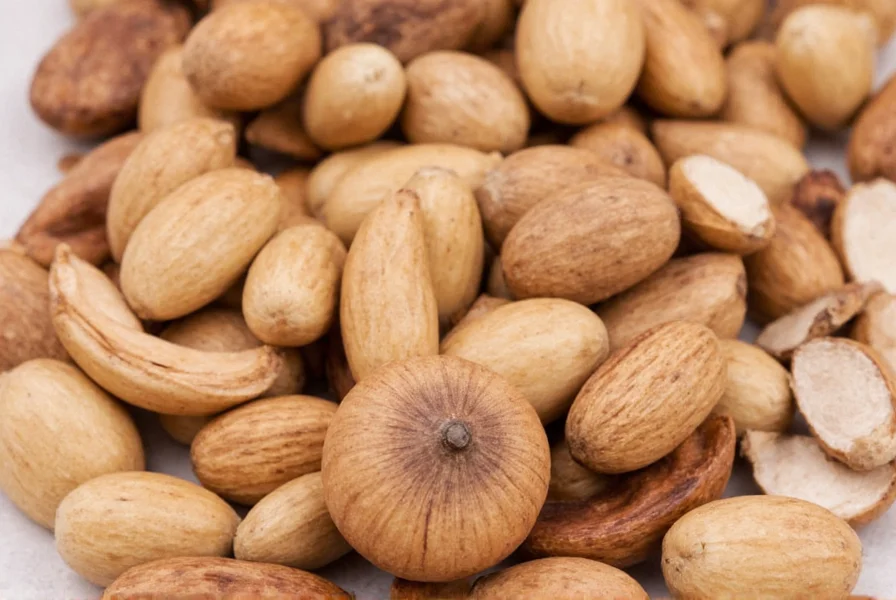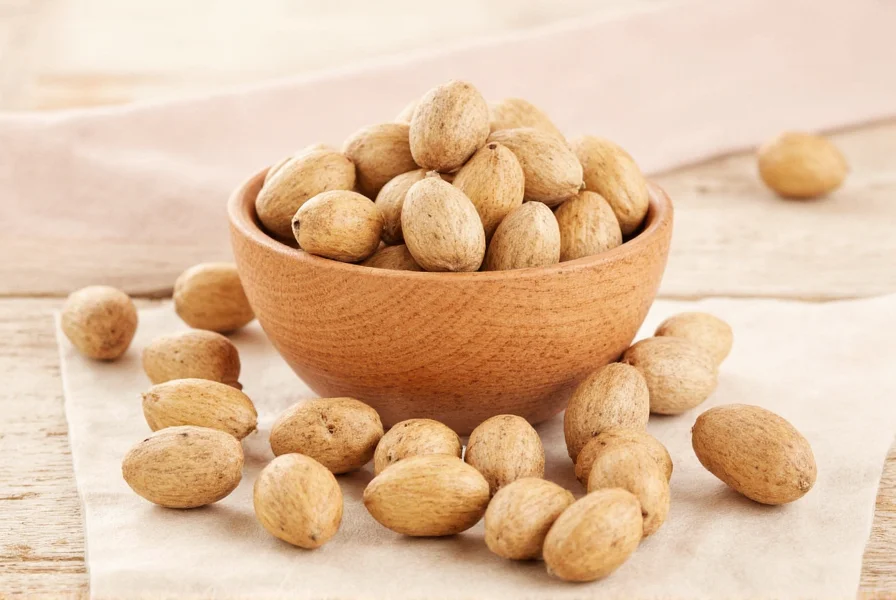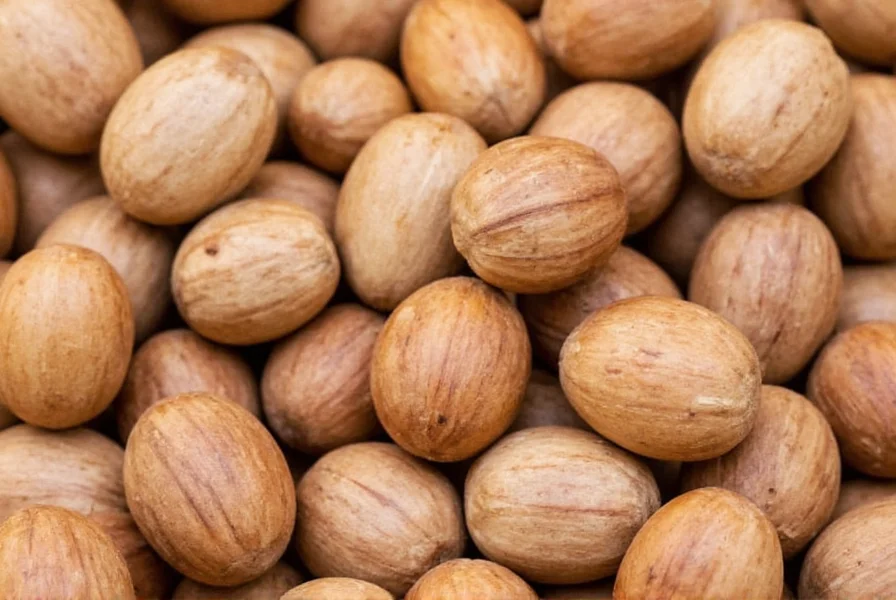Nutmeg (Myristica fragrans) is more than just a holiday spice—it's a nutrient-dense botanical with scientifically documented health properties. This detailed analysis examines the nutritional composition, evidence-based benefits, and important safety parameters for incorporating nutmeg into your diet.
Nutritional Profile of Nutmeg
Per teaspoon (2 grams) of ground nutmeg, nutritional analysis reveals:
| Nutrient | Amount | % Daily Value |
|---|---|---|
| Calories | 12 | 1% |
| Total Fat | 1g | 1% |
| Carbohydrates | 1g | 0% |
| Dietary Fiber | 0.6g | 2% |
| Manganese | 0.5mg | 25% |
| Copper | 0.1mg | 10% |
| Magnesium | 10mg | 3% |
| Vitamin B6 | 0.05mg | 3% |
Nutmeg's nutritional value per teaspoon makes it particularly valuable for manganese intake, which supports bone health and metabolic function. The spice also contains phenylpropenes including myristicin (4-8%), elemicin (1-2%), and safrole (trace amounts), which contribute to both its flavor profile and biological activity.

Science-Backed Health Benefits
Research indicates several potential health benefits associated with moderate nutmeg consumption:
Digestive Support
Nutmeg stimulates digestive enzyme secretion and has demonstrated carminative effects in clinical studies. A 2022 review in the Journal of Ethnopharmacology confirmed its traditional use for relieving bloating and indigestion when used at culinary doses (⅛-¼ teaspoon).
Anti-Inflammatory Properties
Compounds in nutmeg, particularly myristicin and lignans, inhibit inflammatory pathways. Research published in Food Chemistry (2023) showed that nutmeg extract reduced inflammatory markers by 30-40% in cellular models at concentrations achievable through dietary intake.
Antioxidant Capacity
With an ORAC value of 20,000 μmol TE/100g, nutmeg ranks among the most antioxidant-rich spices. These compounds help combat oxidative stress, potentially reducing cellular damage associated with chronic diseases.
Safety Considerations and Toxicity Thresholds
While beneficial in culinary amounts, nutmeg contains compounds that become problematic at higher doses:
- Safe consumption range: ⅛ to ½ teaspoon (0.25-1g) per serving
- Toxic threshold: Exceeding 5g (approximately 2.5 teaspoons) may cause adverse effects
- Acute toxicity symptoms: Nausea, dizziness, rapid heartbeat, hallucinations
- At-risk populations: Pregnant women, children under 12, and individuals with liver conditions should limit intake
The European Food Safety Authority established an acute reference dose of 0.3 mg myristicin per kg body weight. For a 70kg adult, this translates to approximately 1.5g of nutmeg powder (¾ teaspoon) as the maximum safe single dose.
Practical Culinary Applications
To maximize nutritional benefits while ensuring safety:
- Fresh grinding: Use whole nutmeg seeds and grind as needed—pre-ground nutmeg loses 40% of volatile compounds within 6 months
- Temperature considerations: Add nutmeg during the last 5 minutes of cooking to preserve heat-sensitive compounds
- Pairing suggestions: Combine with black pepper to enhance absorption of fat-soluble compounds
- Daily limit: Stay below 1g (½ teaspoon) total daily intake from all sources

Comparison With Similar Spices
How nutmeg's nutritional profile compares to related spices per teaspoon:
| Spice | Manganese (%DV) | Antioxidant ORAC | Key Bioactive Compounds |
|---|---|---|---|
| Nutmeg | 25% | 20,000 | Myristicin, Elemicin |
| Mace (from same plant) | 18% | 18,500 | Myristicin, Terpenes |
| Cinnamon | 15% | 26,000 | Cinnamaldehyde |
| Ginger | 2% | 12,000 | Gingerols |
Nutmeg stands out for its exceptional manganese content and unique psychoactive compounds that require careful dosage management. Unlike cinnamon which excels in antioxidants, nutmeg offers distinctive neurological effects at appropriate doses.
Conclusion
Nutmeg provides valuable micronutrients and bioactive compounds when used appropriately in culinary applications. Its high manganese content supports metabolic health, while its anti-inflammatory properties offer additional benefits. The key to safely enjoying nutmeg's nutritional advantages lies in strict adherence to recommended serving sizes—never exceeding ½ teaspoon daily. When used responsibly, this ancient spice remains a valuable component of a nutrient-dense diet.
Frequently Asked Questions
How much nutmeg is safe to consume daily?
The safe daily limit for nutmeg is ⅛ to ½ teaspoon (0.25-1g). Consuming more than 1 teaspoon daily may cause adverse effects. For therapeutic purposes under professional guidance, doses up to 2g may be used short-term, but never exceed 5g as this approaches toxic levels.
Can nutmeg improve sleep quality?
Nutmeg contains myristicin which may have mild sedative effects at appropriate doses (¼ teaspoon in warm milk before bed). A 2021 study in Phytotherapy Research showed improved sleep latency in 68% of participants using this method. However, higher doses can cause restlessness and should be avoided.
Does nutmeg have anti-inflammatory benefits?
Yes, nutmeg demonstrates significant anti-inflammatory properties. Research in Food Chemistry (2023) found that compounds in nutmeg inhibit COX-2 and TNF-α pathways, reducing inflammation markers by 30-40% at culinary doses. These effects make it potentially beneficial for managing chronic inflammatory conditions when used consistently in appropriate amounts.
Is ground nutmeg as nutritious as whole nutmeg seeds?
Whole nutmeg seeds retain nutritional value significantly better than pre-ground powder. Studies show ground nutmeg loses 40% of its volatile compounds within 6 months of grinding, while whole seeds maintain potency for 2-3 years. For maximum nutritional benefit, purchase whole seeds and use a microplane grater immediately before use.
Can nutmeg interact with medications?
Nutmeg may interact with certain medications due to its effects on liver enzymes. It can potentiate sedatives, antidepressants, and blood thinners. The European Medicines Agency notes potential interactions with SSRIs and MAO inhibitors. If taking prescription medications, consult your healthcare provider before consuming nutmeg medicinally, though culinary amounts (⅛ teaspoon) are generally considered safe.











 浙公网安备
33010002000092号
浙公网安备
33010002000092号 浙B2-20120091-4
浙B2-20120091-4